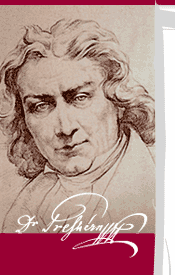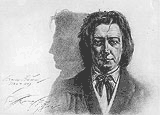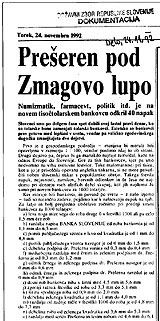
| CONTENTS | ||||||
| Introduction | ||||||
| Life | ||||||
| Works | ||||||
| Miscellaneous | ||||||
|
||||||
| Search | ||||||
| Links | ||||||
| Contributors | ||||||
| Slovenia | ||||||

| |
Vanessa Redgrave and Stane Sever |
| PREŠEREN ON SLOVENE MONEY | ||||||
| After the introduction of temporarily
valid payment notes, which were put into circulation on
the basis of the Law on the use of the monetary unit of
the Republic of Slovenia on the 8th October 1991, preparations
began for the production of "real" Slovene money. New
Slovene tolar bank-notes were supposed to come into circulation
in June 1992, but the representatives of the Government
and the Bank of Slovenia moved the starting date to 30th
September 1992. To begin with, there were bank-notes with
nominal values of 1000, 500 and 100 tolars, which were
to be followed by others. The date on these bank-notes
is 15th January 1991, in memory of the day when Slovenia
received international recognition. The bank-notes were
printed by the British printing house Thomas De La Rue
and Company Limited, using paper produced by the paper-mill
in Radeče. The design of the new Slovene money was carried
out by the designers Miljenko Licul and Zvone Kosovelj,
as well as the academic painter Rudi Španzel. In the Official
Gazette of the Republic of Slovenia, no. 45, published
on 21st September, the Bank of Slovenia, using the date
18th September, promulgated three decrees, referring directly
to the new bank-notes: - Decree on the issuing of 5000, 1000, 500, 200, 100, 50, 20 and 10 tolar bank-notes, - Decree on the putting of 1000, 500 and 100 tolar bank-notes into circulation and - Decree on the main features of the 1000, 500 and 100 tolar bank-notes. Point 4 in the latter decree states the following: |
||||||
| 4. The appearance
of the 1000 tolar bank-note a.) The front The central image on the bank-note is a hand-engraved portrait of France Prešeren, based on a contemporary model. The poet's likeness is supplemented on its left by a shadow of his portrait, filled with microwriting, extending to the greyish-green coloured area. On the right of the poet's portrait there is the inscription "France Prešeren 1800-1849", printed by the intaglio method. Above it, there is a rectangle of green, in which there is a negative of the number "1000". Along the left edge of the bank-note the words "BANKA SLOVENIJE" appear printed by the intaglio method. In the middle of the white area, there is a watermark bearing the image of France Prešeren. Under it, the value of the bank-note is printed in green. To the right of the watermark there is a yellow strip, in which there is a stylized image of a small desk representing an aid to the poet's writing, and at the top of the yellow strip there is a facsimile of Prešeren's signature in green and black, which ends in a grey area containing computer generated protective features. Under this, there is another white area which runs into the protective green pattern. This pattern is darker at the top and lighter towards the bottom edge of the bank-note. Along this green rectangle, the words "TISOČ TOLARJEV" are printed using the intaglio method. In the middle of the bank-note at the bottom, there is a white circle, divided into four equal parts, with segments of a circle drawn in grey. This represents the front part of the identifying ornament. This is supplemented by the negative of these segments in a red circle on the back, so that together they form a composition of two full circles. Over the whole of the note's surface, running from left to right, there is computer generated protection, which ends in the shadow of the poet's portrait. The starting line of the pattern is in the microwriting of the text, consisting of the name of the Bank of Slovenia, the numerical value of the bank-note and the shortened name of the currency. On the left part of the bank-note there is a white area at the top of which there is a recognition feature for the blind, consisting of a relief upright rectangle and three full circles. On the front of the bank-note, the greyish-green and yellow colours are predominant. b) The back In the central section of the note, there is a part of the poem "A Toast", written for New Year 1844, printed on a stylized tonal base. By the left edge of the poem, the value of the note in words "TISOČ TOLARJEV" is printed upright. On the left of the note, there is a protective tonal base, consisting of lines in various colours, which gently change from darker to lighter colour tones. To the right, there is an upright ribbon, at the top of which there is a stylized quill in black on a silver base, whilst on the other three quarters of the ribbon, there is a coloured geometric protection pattern. To the left of the quill, there is the word "Prijatli" from "A Toast" written in the poet's handwriting printed in the intaglio method on a hand-drawn raster. On the bottom part of the note, there is the number denoting the value of the note. Across the whole composition, there lies a spiral combination, which completes the graphic image of the bank-note. At the top of the white area, along the inside edge, the words "GUVERNER" and "ČLAN SVETA BANKE" are printed, and under them the facsimile of the signatures of the Governor of the Bank of Slovenia, Dr France Arhar, and a member of the Council of the Bank of Slovenia, Andrej Rant. In the top right corner, there is a dark grey rectangle in which the negative of the number denoting the value of the note is printed. Underneath, first the place and then the date of the issue of the bank-note are printed: "LJUBLJANA 15. JANUAR 1992". Along the outer edge, the words "BANKA SLOVENIJE" are printed using the intaglio method. Parallel to this, along the inner edge of the white surface, there is the reference number of the note, printed upright in black, consisting of two letters and six numbers. The same reference number is printed in red horizontally on the left side of the note. The predominant colours on the back of the bank-note are grey, orange and red.
|
||||||
|
||||||
|
||||||
|
||||||
| The image of France Prešeren was created
by Academician Rudi Španzel, who combined a number of
hitherto known images of the poet into one. He completed
the image drawing from his extensive knowledge of the
poet's life. On this image, according to some, the poet
is shown as more human and this is precisely what is wrong
with it according to others. The profile of the poet was
taken from an already known image. Personally, I maintain
that Prešeren is shown as a reflective intellectual, who
enjoyed a colourful life, including drink and women, rather
than as a man unhappily in love, as he is described in
the school text books. |
||||||
 The
drawing by Rudi Španzel, which was the base for the creation
of the cliché for the bank-note. The
drawing by Rudi Španzel, which was the base for the creation
of the cliché for the bank-note. |
||||||
The bank-notes printed by the British were to a large extent printed inaccurately and imprecisely, and I published a series of articles in the newspaper Delo about this very poor or imprecise printing by the firm Thomas De La Rue International, or rather by their printing house in Newcastle. The first of these articles was published on 24th November 1992, and it described a number of inaccuracies and imprecisions in the printing of the 1000 tolar bank-note. Through detailed examination I discovered as many as 25 noticeable inaccuracies on the front of the note, and eleven on the back. These mistakes or, more precisely, inaccuracies were found on a sample of 45 bank-notes chosen at random. In addition to the inaccuracies described, there were also some general problems, such as the varying size of the notes, the movement of notes during cutting resulting in different lengths of the printed text so that, for instance, instead of BANKA SLOVENIJE, it said ANKA SLOVENIJE, the too-frequent imprinting of the notes, resulting in stacking sheets which were still damp, and we could probably find others. |
||||||
 Facsimile of the first article, published in Delo on 24th
November 1992 and entitled "Prešeren under Zmago's magnifying
glass", describing the inaccuracies and imprecisions on
the bank-notes.
Facsimile of the first article, published in Delo on 24th
November 1992 and entitled "Prešeren under Zmago's magnifying
glass", describing the inaccuracies and imprecisions on
the bank-notes.The Bank of Slovenia, together with the British printers, started preparing the issue of a new series of the 1000 tolar bank-note. First, they changed the portrait of the poet, which differs from the previous one in the collar of the jacket, the knot on the neck-scarf, the narrower face, the slightly altered arc above the eyes, the changed eyes and a less prominent chin. This new portrait was first used for a trial imprint on top of the old base of the bank-note issued on 15th January 1992. |
||||||
|
||||||
| The Bank of Slovenia issued a new decree
in connection with the new bank-notes. Decree on the change of the decree about the main features of the 1000, 500 and 100 tolar bank-notes 1. The Bank of Slovenia is changing the main features of the 1000 tolar bank-note, as determined by the Decree on the main features of the 1000, 500 and 100 tolar bank-notes for 1000, 500 and 1000 tolars (Official Gazette RS, no. 46/92). 2. On the bank-note for 1000 tolars the following features will be changed: a) The front: ˇ a new engraving of the image of France Prešeren, based on an original model, will be used on the new bank-note; ˇ the colour of the rectangle containing the negative imprint of the value of the bank-note in the top right corner will change from light green to dark blue-green; ˇ the facsimile of Prešeren's signature will be printed in the intaglio method in black only; ˇ the value of the bank-note, printed as the number bottom left will be in dark blue-green colour. The same colour will be used for the value expressed with the words "TISOČ TOLARJEV"; ˇ the computer generated protection of the bank-note, ending in the shadow of the poet's image, will be printed in orange, changing through blue-green into black. b) The back ˇ the colour of the word "Prijatli" in the top left corner printed in the intaglio method will be changed from black to orange; ˇ the number and words denoting the value of the bank- note will be printed in dark blue-green colour; ˇ the computer animation of the spiral combination will be printed in black, changing trough dark blue-green into orange; ˇ the date of the issue of the note will be "1. JUNIJ 1993". 3. This decree comes into force with the date of notification in the Official Gazette. The decree was published on 7th December 1993, signed by Governor Dr France Arhar. On the same day, the "Decree on putting the 1000 tolar bank-note into circulation" was published, point 2 of which states that in addition to the new notes, the old notes from the first issue remain valid. The series of the new bank-notes were: LZ, MZ, NZ, PZ, RZ, SZ, TZ, UZ, VZ, ZZ and the transition series ZA. An approximate total of 10,020,000 of these notes were issued. |
||||||
|
||||||
|
||||||
|
||||||
|
||||||
| Even before the Republic of Slovenia
published its own money - firstly just the payment notes,
followed by the real bank-notes - Dr Bogdan Oblak Hamurabi
had designed new Slovene money. Serious work on this project
started on 15th May 1989, when the later founders of the
Lipa Holding firm adopted a decree on the new Slovene
currency, which they had named "the lipa". Lipa Holding
prepared an issue of notes for 1, 1, 2, 5, 10, 20, 50
and 100 lipa. On the 100 lipa bank-note, there was to
be a portrait of France Prešeren, designed by Klemen Rodman
from Radovljica, who also designed the rest of the series
of bank-notes. They were supposed to be of equal size
- 65 mm by 130 mm - in portrait format but, of the whole
series, only notes for 1 lipa were ever printed. Before these other bank-notes were proposed, there was only a 1 lipa bank-note in circulation, which had Dr France Prešeren on the front right, on the left there is a flowering linden-tree (lipa), and in the centre, above the silhouette of the ducal stone and the inscription Banka Slovenije, as well as the number denoting the value of the note. On the back, in the middle, there is a picture of a model of a new Slovene parliament designed by the architect Jože Plečnik, on the right, there is again a flowering linden-tree, and on the left the ducal stone. On both back and front, there is the number denoting the value of the note and the words "Banka Slovenije". The reference number appears only on the back right. A few variants of this bank-note were printed, and there were at least ten thousand 1 lipa bank-notes in circulation - the number issued in line with a decree passed by the Lipa Holding assembly. They were used as an additional means of payment. Later, even more bank-notes were printed. The first lipa bank-notes appeared in circulation in Ljubljana on 31st March 1990. Contracts with more than 80 firms had been drawn up, in which the firms agreed to accept lipas as an additional method of payment. It is interesting that there were also forgeries of this bank-note, and when silver coins were issued, the false bank-notes could be exchanged for the coins. |
||||||
|
||||||
|
||||||
|
||||||
|
||||||
| Lipas were well received by the people;
soon, shops and restaurants in Ljubljana started accepting
them, and they began using them elsewhere, too, exchanging
them for dinars at the rate of 1 lipa = 49.02 dinars (on
23rd May 1990). At the proclamation of Slovenia's independence on 2nd July 1990, Lipa Holding also issued two coins. Zlatarna Celje was, according to an order from Lipa Holding, supposed to mint three hundred 50 lipa gold coins, but instead they minted three hundred 1 lipa silver coins. Later, more coins were minted. Models for both gold and silver coins were created by the medallist Stane Dremelj. |
||||||
 |
||||||
| 1 lipa silver coin, minted in Zlatarna
Celje; four variations of this coin are known; approximately
8000 coins were produced in total. |
||||||
 |
||||||
| 50 lipa gold coin, minted in Zlatarna
Celje; two variations of the coin are known; approximately
80 such coins were produced in total. |
||||||
Zmago pl. Jelinčič |
||||||
| Ljubljana, 23rd October 2000 | ||||||






















